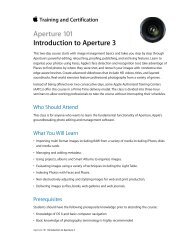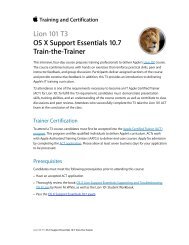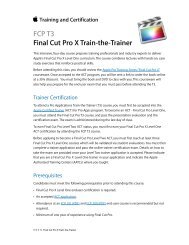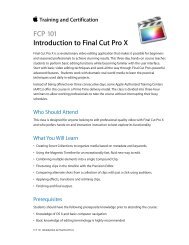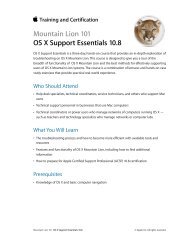OS X Support Essentials 10.8 - Training - Apple
OS X Support Essentials 10.8 - Training - Apple
OS X Support Essentials 10.8 - Training - Apple
You also want an ePaper? Increase the reach of your titles
YUMPU automatically turns print PDFs into web optimized ePapers that Google loves.
<strong>OS</strong> X <strong>Support</strong> <strong>Essentials</strong> <strong>10.8</strong> Exam Preparation Guide<br />
logical network connections that ride on top of hardware<br />
network connections. A protocol is a set of rules used to<br />
describe a specific type of network communication. Protocols<br />
are necessary for separate network devices to communicate<br />
properly. Finally, a service (as it pertains to the Network<br />
preference) is the collection of settings that define a network<br />
connection.<br />
2. The Internet Protocol (IP) address identifies the location of a<br />
specific network device. IP addresses are the primary<br />
identification used by the Internet protocol suite TCP/IP for<br />
both local area and wide area networks. Subnet masks are<br />
used by network devices to identify their local network range<br />
and to determine if outgoing data is destined for a network<br />
device on the LAN.<br />
3. Most common IP addresses and subnet masks share the same<br />
IPv4 formatting. An IPv4 address is a 32-bit number<br />
represented in four groups of three-digit numbers, known as<br />
octets, separated by periods. Each octet has a value between<br />
0 and 255. An IPv6 address is a 128-bit number that’s<br />
presented in eight groups of four-digit hexadecimal numbers<br />
separated by colons. This allows for a huge range of<br />
addresses, and as a result IPv6 addressing essentially includes<br />
subnet information.<br />
4. If a network device needs to send data to another network<br />
device on the same LAN, it addresses the outgoing packets<br />
based on the destination device’s MAC address.<br />
5. A network client uses the subnet mask to determine if the<br />
destination IP address is on the LAN. If the destination IP<br />
address isn’t on the LAN, it’s assumed the destination address<br />
is on another network, and the client sends the data to the IP<br />
address of the local network router. The network router then<br />
sends the data, via a WAN connection, on to another router<br />
that’s closer to the destination. This continues across WAN<br />
connections from router to router until the data reaches its<br />
destination.<br />
6. The DNS service is used to translate host names to IP<br />
addresses via forward lookups and translate IP addresses to<br />
host names via reverse lookups. DNS is architected as a<br />
hierarchy of worldwide domain servers. Local DNS servers<br />
provide name resolution and possibly host names for local<br />
clients. These local DNS servers connect to DNS servers higher<br />
in the hierarchy to resolve both unknown host names and<br />
host local domain names.<br />
7. A service set identifier, or SSID, is used to identify a Wi-Fi<br />
network name and associated configuration.<br />
8. <strong>OS</strong> X supports authenticated Wi-Fi via the following<br />
authentication protocols: WEP, WPA/WPA2 Personal, and WPA/<br />
WPA2 Enterprise, which includes support for 802.1X<br />
authentication.<br />
36



